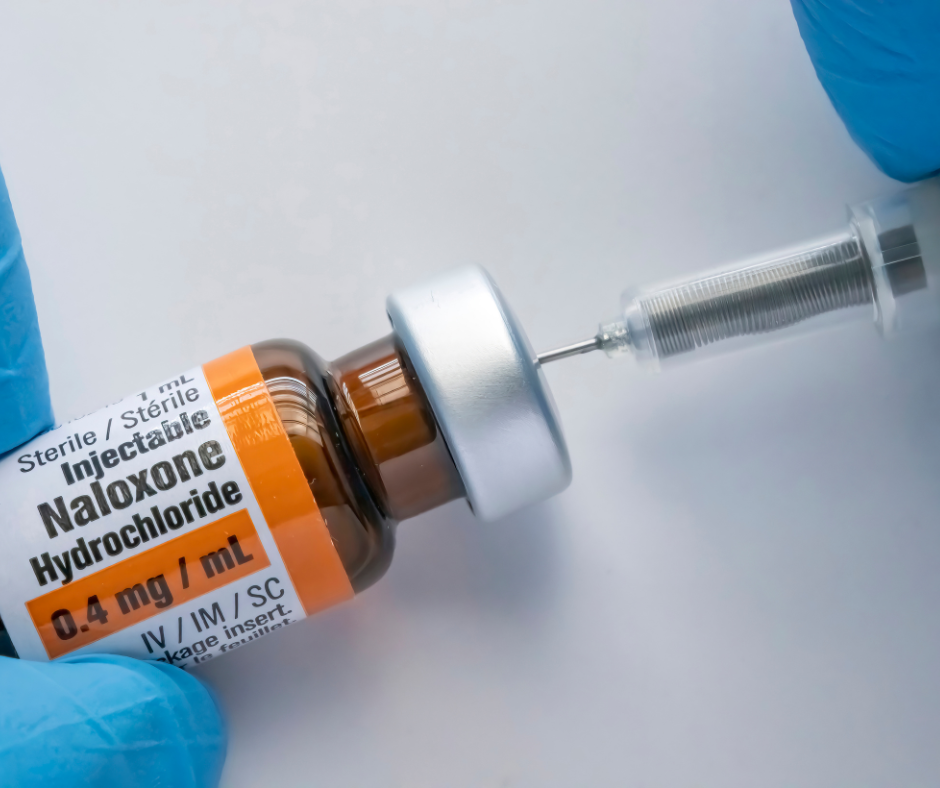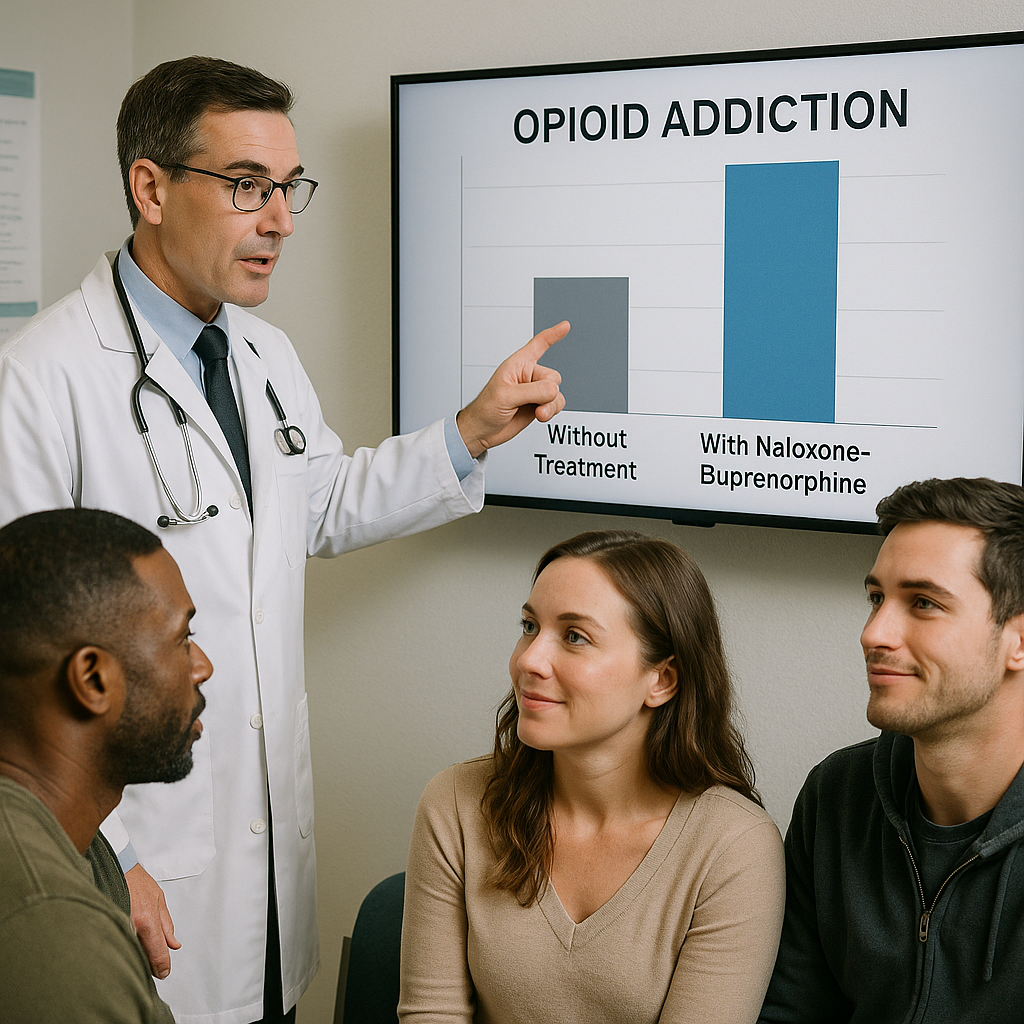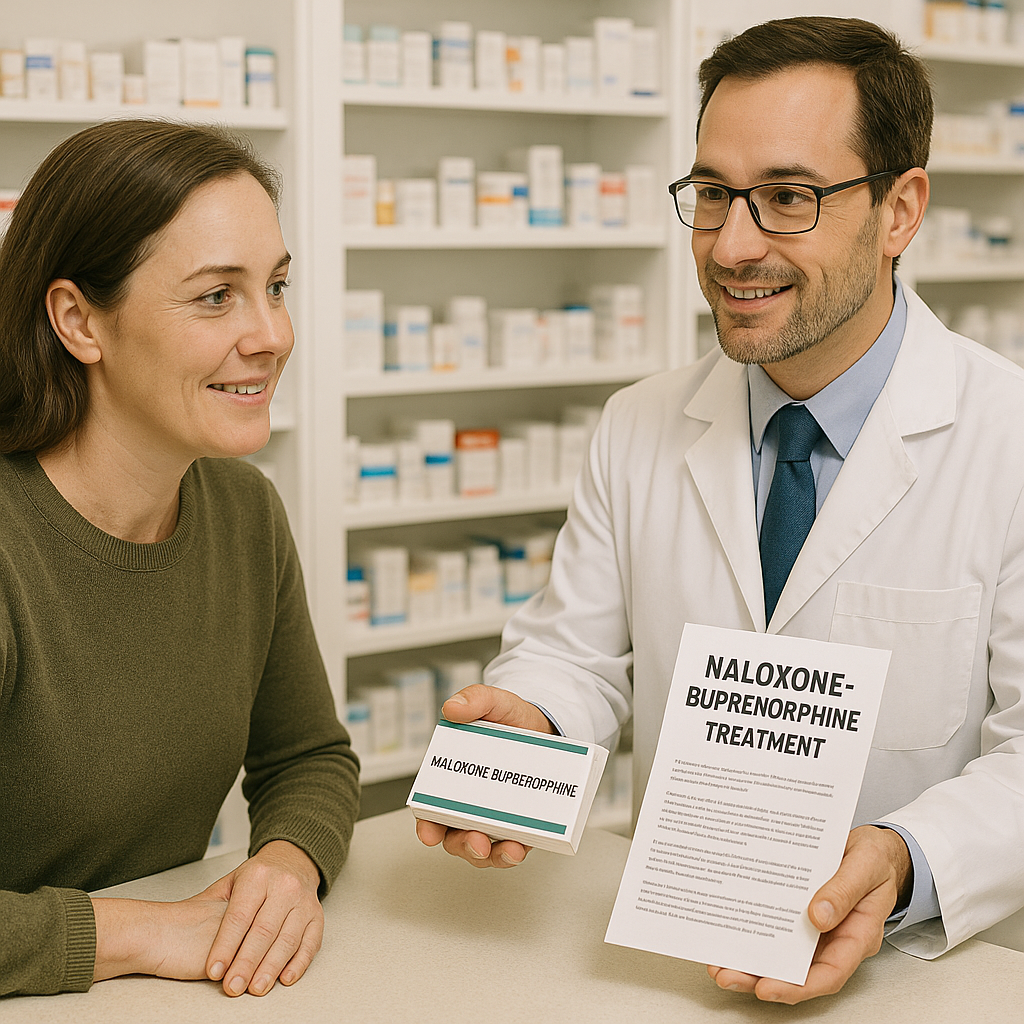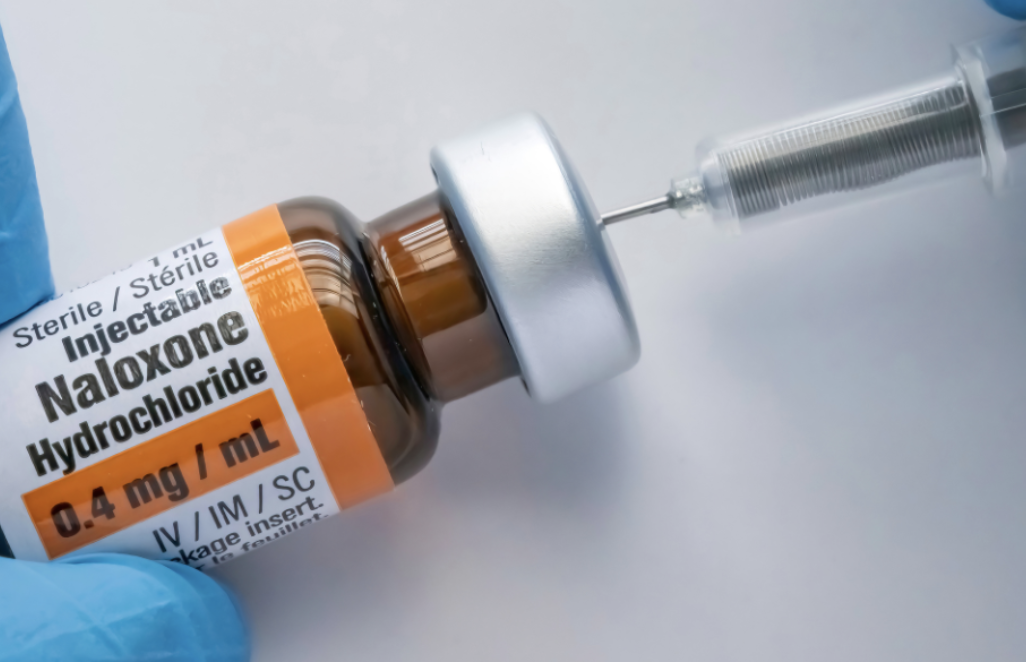Naloxone buprenorphine treats opioid use disorder by reducing misuse and cravings. Learn about its uses, how it works, and its role in addiction treatment.
Key Takeaways
- Naloxone buprenorphine is an FDA-approved medication for treating opioid use disorder, effectively reducing cravings and opioid misuse.
- The combination of buprenorphine, a partial opioid agonist, and naloxone, an opioid antagonist, provides a comprehensive approach to managing opioid dependence while minimizing the risk of misuse and overdose.
- Compared to methadone and naltrexone, naloxone buprenorphine offers similar efficacy in reducing withdrawal symptoms and cravings with a lower risk of overdose, and it can be safely used during pregnancy.
What is naloxone buprenorphine used for?
Naloxone buprenorphine, often prescribed under the brand name Suboxone, is a combination medication approved to treat opioid use disorder (OUD). The U.S. Food and Drug Administration (FDA) has approved this medication specifically for individuals battling OUD, signifying its pivotal role in addiction medicine.
This combination is effective in reducing opioid misuse and cravings, which are critical in the journey toward recovery from opioid dependence. Naloxone buprenorphine reduces the urge to consume opioids, helping patients stabilize their lives and break the cycle of addiction.
Moreover, its dual-action mechanism provides a balanced approach, addressing both the immediate and long-term needs of patients receiving buprenorphine treatment. This makes it an indispensable tool in the arsenal against the ongoing opioid epidemic.

How does naloxone buprenorphine work in the body?
Buprenorphine, a partial opioid agonist, plays a crucial role in managing opioid dependence. It activates the mu opioid receptor and mu receptors, providing pain relief and mitigating withdrawal symptoms without the intense euphoria of full opioid agonists like heroin or morphine. This ceiling effect minimizes the risk of addiction and overdose, making it a safer alternative for treating opioid tolerance and opioid dependence.
Naloxone, on the other hand, functions as an opioid antagonist. It blocks the effects of opioids on the central nervous system, preventing misuse. When taken as prescribed, naloxone’s effects are minimal due to poor absorption via the sublingual route. However, if the medication is injected, naloxone can precipitate withdrawal symptoms, acting as a deterrent against misuse.
The sublingual administration of naloxone buprenorphine ensures that the medication is absorbed effectively while reducing the risk of misuse. The combination of these two medications addresses both the physiological and psychological aspects of opioid dependency, offering a comprehensive approach to treatment.
Naloxone vs. buprenorphine: Key differences and complementary roles
Buprenorphine and naloxone have distinct roles that complement each other in the treatment of opioid addiction. Buprenorphine, as a partial opioid agonist, binds to opioid receptors with high affinity, providing enough activation to reduce withdrawal symptoms and cravings without causing significant euphoria. This makes it a suitable option to treat opioid dependence for long-term management.
In contrast, naloxone is a pure opioid antagonist with antagonist properties. It binds to opioid receptors without activating them, effectively blocking the effects of other opioids. This property is particularly useful in preventing overdose and misuse. When combined, buprenorphine and naloxone create a medication that not only treats opioid dependence but also reduces the risk of abuse. Opioid antagonists play a crucial role in this process.
The synergy between these two components lies in their ability to balance efficacy and safety. While buprenorphine addresses the withdrawal and craving aspects, naloxone ensures that the medication is not misused, thereby providing a safer and more effective treatment option for patients.
Effectiveness of naloxone buprenorphine in opioid addiction treatment
Clinical trials have demonstrated the effectiveness of buprenorphine-naloxone in reducing cravings and opioid withdrawal symptoms in individuals with opioid use disorder. This combination has been shown to significantly reduce opioid use and improve treatment retention rates, which are critical factors in successful long-term recovery.
Studies comparing buprenorphine/naloxone to methadone have found that both medications achieve similar outcomes in reducing opioid use and withdrawal symptoms, as seen in many Suboxone vs methadone comparisons. However, patients treated with buprenorphine/naloxone are less likely to suffer from overdose deaths compared to those who do not receive treatment.
Buprenorphine/naloxone treatment also decreases risky behaviors associated with the transmission of infectious diseases such as HIV. Initiating treatment in emergency settings has also been found to motivate individuals to pursue long-term care, further highlighting the medication’s role in comprehensive addiction treatment.

Who should take naloxone buprenorphine?
Naloxone buprenorphine is ideally suited for individuals with moderate to severe opioid use disorder (OUD). These patients often struggle with opioid dependence and require a structured medication-assisted treatment (MAT) plan to achieve and maintain recovery.
Before starting buprenorphine treatment, necessary screening and pre-treatment evaluations are conducted to ensure the patient’s suitability for the medication. This includes assessing the severity of opioid dependency, any co-occurring mental health conditions, and the patient’s overall health status.
Certain populations may require additional considerations. For example, pregnant individuals and adolescents may benefit from buprenorphine treatment but need careful monitoring and guidance from healthcare providers. Tailoring the treatment plan to the individual’s specific needs ensures the best possible outcomes.
Risks and side effects of naloxone buprenorphine
Like any medication, naloxone buprenorphine comes with potential side effects. Common side effects include headache, nausea, insomnia, and constipation. These are generally manageable and tend to diminish as the body adjusts to the medication.
More serious risks, although rare, include respiratory depression. However, due to buprenorphine’s ceiling effect, the risk of fatal respiratory depression is significantly lower compared to full opioid agonists. It’s crucial for patients to use the medication as prescribed to avoid any adverse effects.
Combining naloxone buprenorphine with other medications such as benzodiazepines or alcohol can increase the risk of severe withdrawal symptoms and respiratory depression. Patients should be closely monitored and advised on the safe use of the medication to prevent any complications.
How is naloxone buprenorphine prescribed and administered?
The prescription and administration of naloxone buprenorphine follow specific guidelines. The treatment typically begins with an induction phase, where the initial buprenorphine dose is carefully adjusted to manage withdrawal symptoms. This is followed by a maintenance phase, where the dosage is stabilized to ensure long-term effectiveness.
Naloxone buprenorphine is commonly administered sublingually, either as a sublingual tablet or a sublingual tablet formulation or sublingual film or buccal films or sublingual formulations in various dosage forms. This method ensures efficient absorption while minimizing the risk of misuse. Patients are instructed to place the medication under the tongue and allow it to dissolve completely.
The duration of treatment varies based on individual needs and response to the medication. Some patients may require long-term maintenance treatment, while others may gradually taper off under medical supervision. The goal is to achieve sustained recovery and prevent relapse.
How to access naloxone buprenorphine treatment
Accessing naloxone buprenorphine treatment involves obtaining a prescription from a qualified healthcare provider. Under the Drug Addiction Treatment Act, clinicians with the necessary waiver can prescribe buprenorphine-naloxone for opioid use disorder treatment. Telehealth options have also expanded access, allowing patients to receive care remotely.
Common brand names for naloxone buprenorphine include Suboxone, Zubsolv, and Bunavail. These formulations come in various dosages and delivery methods, providing flexibility in treatment plans.
Cost and insurance coverage can vary, but many insurance plans cover the medication, and generic versions are available to reduce costs. Patients should discuss their options with their healthcare providers to find the most suitable and affordable treatment plan.

Naloxone buprenorphine vs. methadone and naltrexone
Comparing naloxone buprenorphine with methadone and naltrexone offers insight into different treatment options for opioid addiction. Methadone, a full agonists opioid agonist, is highly effective but requires daily visits to a methadone clinic, which can be a barrier for some patients. Buprenorphine, with its partial agonist properties, provides similar efficacy with a lower risk of overdose.
Naltrexone, unlike buprenorphine, does not activate opioid receptors and is used primarily for relapse prevention. It requires complete detoxification before initiation, which can be challenging for some patients. Both buprenorphine/naloxone and naltrexone have been shown to reduce cravings and the risk of overdose, making them viable alternatives to methadone.
Patients using buprenorphine/naloxone typically experience fewer side effects and lower risks of misuse compared to those on methadone. Each medication has its benefits and risks, and the choice depends on the individual’s specific needs and circumstances.
Considerations for pregnant individuals using naloxone buprenorphine
When it comes to treating opioid dependence during pregnancy, naloxone buprenorphine offers a promising option. Studies have shown that buprenorphine-naloxone is safe for use during pregnancy and can help manage opioid addiction effectively, as outlined in Suboxone and pregnancy guidelines. Pregnant women treated with this medication tend to have normal birth weights, significantly higher than those exposed to other narcotics.
The American College of Obstetricians and Gynecologists (ACOG) and other health authorities recommend the use of this combination for pregnant women with opioid use disorder, emphasizing its benefits in reducing illicit opioid use and improving overall maternal and fetal outcomes. The FDA classifies buprenorphine-naloxone as category C, indicating that the potential benefits may outweigh the risks.
Systemic absorption of the naloxone component is minimal, reducing its impact on the fetus due to the first-pass effect. However, healthcare providers must carefully monitor pregnant patients and may consider switching to another long-acting narcotic based on individual needs and circumstances.
Harm-reduction strategies, such as tapering narcotics, can also be employed to reduce the risk of neonatal opioid withdrawal syndrome (NAS). This approach ensures that both the mother and the baby receive the best possible care.

Where to find support and further information
For those seeking support and further information on naloxone buprenorphine treatment, several resources are available. The Substance Abuse and Mental Health Services Administration (SAMHSA) provides helplines and treatment locators to assist individuals in finding the right care. Local medication-assisted treatment (MAT) clinics and telehealth options can also provide valuable support.
Consulting a licensed addiction treatment provider is essential for personalized care in addressing substance use disorder. Official guidelines from the Centers for Disease Control and Prevention (CDC), National Institutes of Health (NIH), and the U.S. Food and Drug Administration (FDA) offer additional information, including a medication guide and guidance for those seeking treatment.
Bottom line: Naloxone Buprenorphine
Naloxone buprenorphine stands out as a highly effective treatment for opioid use disorder, offering a balanced approach that addresses both the psychological and physiological aspects of addiction. Its ability to reduce cravings and withdrawal symptoms while minimizing the risk of misuse makes it a valuable tool in combating the opioid epidemic.
As we continue to battle opioid addiction, naloxone buprenorphine provides hope and a path toward recovery. By understanding its uses, mechanisms, and benefits, we can better support those in need and work towards a future free from the grips of opioid dependence.
FAQs about Naloxone Buprenorphine
Can you get high on naloxone buprenorphine?
You cannot get high on naloxone buprenorphine due to its design to minimize misuse and the ceiling effect of buprenorphine, which limits euphoria, addressing common concerns like does Suboxone get you high. Therefore, the risk of experiencing a high is significantly reduced.
What happens if someone injects it?
Injecting naloxone and buprenorphine can lead to withdrawal symptoms because naloxone blocks opioid receptors, counteracting the effects of buprenorphine. This serves as a deterrent against misuse.
Is it safe to use with antidepressants?
It is generally safe to use naloxone buprenorphine with antidepressants, provided this is done under the supervision of a healthcare provider to minimize potential interactions.
How long should someone stay on this medication?
The duration of treatment with naloxone buprenorphine varies depending on individual needs; some may require long-term maintenance, while others might taper off under medical supervision. Ultimately, the focus should be on achieving sustained recovery and preventing relapse.
Where can I find support and further information?
You can find support and further information through resources like SAMHSA helplines, local MAT clinics, and official guidelines from organizations such as the CDC, NIH, and FDA. These resources are essential for those seeking treatment with naloxone or buprenorphine.
















